 Visit the C-130 web page at
Robins Air Force Base, Georgia.
Visit the C-130 web page at
Robins Air Force Base, Georgia.A pictorial view of Captain Chris Miller's experiences in southwest Asia
Life in Tent City : Visit the ALCC : Tour the AOR : Kuwait City : Write Me
 Visit the C-130 web page at
Robins Air Force Base, Georgia.
Visit the C-130 web page at
Robins Air Force Base, Georgia.
Visit Hercules Headquarters, the finest site on the web for C-130 related information and links.
I had been in the Air Force for about eight years, a C-130 Flight Examiner Navigator, and had recently been re-assigned to the 317th Tactical Airlift Wing Combat Tactics Branch at Pope Air Force Base in North Carolina. August 3rd of 1991, Saddam Hussein ordered his Republican Guard across the border into Kuwait. The United States responded by putting elements of their Armed Forces on alert. As we were co-located with the XVIII Airborne Corps and the 82d Airborne Division over at Fort Bragg, when they went on alert, we did too. Our office went to 24 hour operations, and we prepared to receive and process the flow of C-5 and C-141 traffic we expected on the "Green Ramp". At 3 AM on the evening of my fourth shift, my boss, Major Joe Bob Stuka, came in and said, "Go on home and get some sleep, Chris. Come back at 7. You're going to McGuire". Seventy-two hours later, I was stepping off a C-5 in Riyadh, Saudi Arabia to begin 211 days of service in my third contingency. What follows are some photos of my experiences there, and the stories behind them.
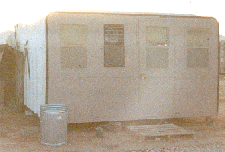 When
we first arrived in theater, we had 12 days in a great hotel. Then they
moved us onto the air base...into something called a "Harvest Bear".
This quaint little shack was originally designed as a combat morgue, and
could hold about 40 bodies in cold storage. For us, it slept twelve in
air conditioned comfort.
When
we first arrived in theater, we had 12 days in a great hotel. Then they
moved us onto the air base...into something called a "Harvest Bear".
This quaint little shack was originally designed as a combat morgue, and
could hold about 40 bodies in cold storage. For us, it slept twelve in
air conditioned comfort.
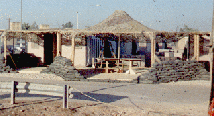 In
keeping with the theater commanders morale program, MWR chipped in to procure
plywood and 2x4s in order to construct a recreation tent. The front porch
was frequently crowded with people who hated to run, already had a shower,
and couldn't go to work or sleep. Inside was a candy counter, "Dear
Any U.S. Servicemember" mail, a video cassette player, and the laundry
drop. The sand bags around the outside were designed to block shrapnel
in the event the base was bombed.
In
keeping with the theater commanders morale program, MWR chipped in to procure
plywood and 2x4s in order to construct a recreation tent. The front porch
was frequently crowded with people who hated to run, already had a shower,
and couldn't go to work or sleep. Inside was a candy counter, "Dear
Any U.S. Servicemember" mail, a video cassette player, and the laundry
drop. The sand bags around the outside were designed to block shrapnel
in the event the base was bombed.
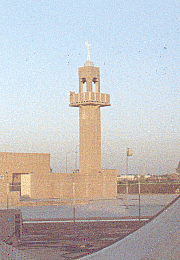 No
matter what shift you worked, and what your designated "sleep time"
was, you could be sure that you would know the time at least five times
a day. The loudspeakers in the top of this prayer tower blared Muslim prayer
at dawn, dusk, and three times in between. I worked the night shift, and
slept from about 9AM till about 3PM, so this was a particularly daunting
adventure for me. After three weeks, I could finally sleep through the
noon prayer...
No
matter what shift you worked, and what your designated "sleep time"
was, you could be sure that you would know the time at least five times
a day. The loudspeakers in the top of this prayer tower blared Muslim prayer
at dawn, dusk, and three times in between. I worked the night shift, and
slept from about 9AM till about 3PM, so this was a particularly daunting
adventure for me. After three weeks, I could finally sleep through the
noon prayer...
 Our
water rations, MREs, and gun locker were all too much for our meager storage.
So, we were forced to store outside in a relatively open area between the
ALCC and the RSAF HQ mosque. Because the area was non-secure,
we took turns pulling guard duty. Here I am holding the M-16 they issued.
Bit of trivia here, but the clip in the rifle is empty. We were not allowed
to load the real bullets for fear that we may accidentally discharge the
rifle and hurt someone. So much for our faith in the Air Force training
programs...
Our
water rations, MREs, and gun locker were all too much for our meager storage.
So, we were forced to store outside in a relatively open area between the
ALCC and the RSAF HQ mosque. Because the area was non-secure,
we took turns pulling guard duty. Here I am holding the M-16 they issued.
Bit of trivia here, but the clip in the rifle is empty. We were not allowed
to load the real bullets for fear that we may accidentally discharge the
rifle and hurt someone. So much for our faith in the Air Force training
programs...
 Here
was one training program that we never tired of... Every time we got a
rumor of a SCUD missile launch, a possible terrorist action, or bad food
at the chow hall, we would be ordered to assume one of the various defensive
postures known as MOPP Levels.
Here
was one training program that we never tired of... Every time we got a
rumor of a SCUD missile launch, a possible terrorist action, or bad food
at the chow hall, we would be ordered to assume one of the various defensive
postures known as MOPP Levels.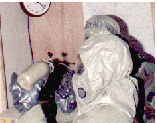 Depicted here, we see me posing for a picture in the alternate ALCC, which
was in the hallway of the RSAF HQ building. Here we see one of my
compatriots in the alternate
Depicted here, we see me posing for a picture in the alternate ALCC, which
was in the hallway of the RSAF HQ building. Here we see one of my
compatriots in the alternate 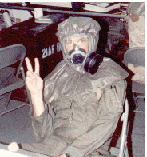 ALCC
attempting to drink from a canteen through the little tube in the nose
of the gas mask. By the time the tube and the canteen had been detoxed
ALCC
attempting to drink from a canteen through the little tube in the nose
of the gas mask. By the time the tube and the canteen had been detoxed
 (a
LENGTHY process), he was too dehydrated to drink. Here, Bill demonstrates
the use of the new M-25 gas mask, patterned after a British design, and
MUCH easier to see out of. ...and here, we see our faithful Current
Operations Branch (Airlift Scheduling) defying the Iraqis by continuing
to work during a drill.
(a
LENGTHY process), he was too dehydrated to drink. Here, Bill demonstrates
the use of the new M-25 gas mask, patterned after a British design, and
MUCH easier to see out of. ...and here, we see our faithful Current
Operations Branch (Airlift Scheduling) defying the Iraqis by continuing
to work during a drill.
Our primary job in the theater of operations was intra-theater
airlift - moving people, parts, munitions, food, water, fuel, you name
it - from one air base to another. Typically, the "Big MAC" folks
would bring in huge amounts of stuff to an aerial port of debarkation,
then Aerial Port would transload to the Herks for the last leg of the relay. The
herks were stationed all over the peninsula - Saudi, Oman, UAE - and were
flying upwards of 120 missions daily; so there was never anywhere you could
land without seeing several. These are on the main ramp at one of the composite
wings.
The
herks were stationed all over the peninsula - Saudi, Oman, UAE - and were
flying upwards of 120 missions daily; so there was never anywhere you could
land without seeing several. These are on the main ramp at one of the composite
wings. 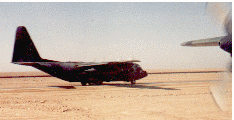 Here
we see a Herk taxiing on a dirt strip in the forward operating area.
Here
we see a Herk taxiing on a dirt strip in the forward operating area. 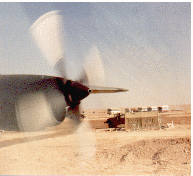 Here's
a shot of the portable shelters taken from the pilot's side window.
Here's
a shot of the portable shelters taken from the pilot's side window. 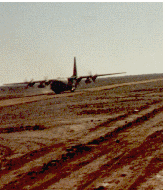 These
guys landed right behind us at Log Base Charlie on tapline road. "Charlie"
was one of the airstrips set up by the XVIII Abn Corps to get cargo
moved into the division rear area right before the "End Run".
These
guys landed right behind us at Log Base Charlie on tapline road. "Charlie"
was one of the airstrips set up by the XVIII Abn Corps to get cargo
moved into the division rear area right before the "End Run".
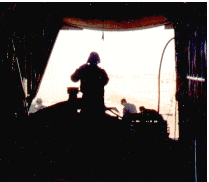 The
loadmaster's job is the whole reason we fly. This loadmaster has the ramp
and door opened on our taxi in at Log Base Charlie in order to expedite
the offload of the fuel from the bladders we are carrying. The flow was
one takeoff and one landing every ten minutes, with a maximum-on-ground
(MOG) of 5. This meant we had about 40 to 45 minutes to drain the bladders
and get airborne again without screwing up the traffic pattern.
The
loadmaster's job is the whole reason we fly. This loadmaster has the ramp
and door opened on our taxi in at Log Base Charlie in order to expedite
the offload of the fuel from the bladders we are carrying. The flow was
one takeoff and one landing every ten minutes, with a maximum-on-ground
(MOG) of 5. This meant we had about 40 to 45 minutes to drain the bladders
and get airborne again without screwing up the traffic pattern.  This
is what Log Base Charlie looked like right after takeoff. Note that tapline
road was the major traffic artery between Dhahran and the extreme northwest
corner of the kingdom, and traffic had to be diverted around the landing
area. We landed the Herks on a road that was 40 feet wide with packed sand-and-oil
shoulders. Whatta Ride!
This
is what Log Base Charlie looked like right after takeoff. Note that tapline
road was the major traffic artery between Dhahran and the extreme northwest
corner of the kingdom, and traffic had to be diverted around the landing
area. We landed the Herks on a road that was 40 feet wide with packed sand-and-oil
shoulders. Whatta Ride! 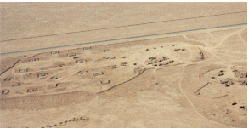 These
are the guys we were supporting...elements of the 82d Airborne camped out
a mere 15 miles from the Iraqi border. Less than 30 days later, these guys
were sitting on the Euphrates River wondering where the opposition went.
These
are the guys we were supporting...elements of the 82d Airborne camped out
a mere 15 miles from the Iraqi border. Less than 30 days later, these guys
were sitting on the Euphrates River wondering where the opposition went.
Well, after over 40 days of repeated pounding by allied air
power, and nearly 100 hours of armed engagement with our ground forces,
the Iraqis gave up. 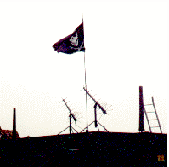 Flying
into Kuwait City was a real rush. We had to shoot the Airborne Radar Approach
through almost 10,000 of smoke from burning oil wells. The runways and
taxiways had not been totally cleared of unexploded ordinance yet. Bombed
out buildings and burning cars littered the airfield. But we just couldn't
help but get some pictures to remember it by.
Flying
into Kuwait City was a real rush. We had to shoot the Airborne Radar Approach
through almost 10,000 of smoke from burning oil wells. The runways and
taxiways had not been totally cleared of unexploded ordinance yet. Bombed
out buildings and burning cars littered the airfield. But we just couldn't
help but get some pictures to remember it by. 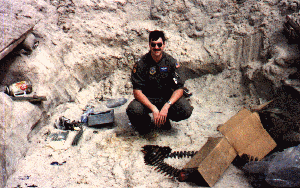 The
first thing I remembered was the Skull and Crossbones flying over the MRCC
van housing the Airlift Control Element. These guys were fantastic. in
the absence of any air traffic control, they kept track of our flight paths
on a sheet of graph paper, and notified the airplanes when it looked like
there was a close call.
The
first thing I remembered was the Skull and Crossbones flying over the MRCC
van housing the Airlift Control Element. These guys were fantastic. in
the absence of any air traffic control, they kept track of our flight paths
on a sheet of graph paper, and notified the airplanes when it looked like
there was a close call. 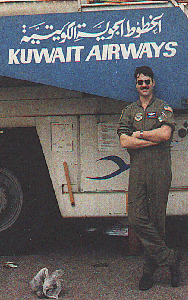 I
hope they got medals, 'cause they deserved 'em. I poked around in this
bunker for almost fifteen minutes looking for souvenirs before EOD explained
that it hadn't been cleared yet. Oops! Found a couple of expended 14.5mm
anti-aircraft shells, but it wasn't worth hanging around for more. Had
to have proof I was there,
I
hope they got medals, 'cause they deserved 'em. I poked around in this
bunker for almost fifteen minutes looking for souvenirs before EOD explained
that it hadn't been cleared yet. Oops! Found a couple of expended 14.5mm
anti-aircraft shells, but it wasn't worth hanging around for more. Had
to have proof I was there, 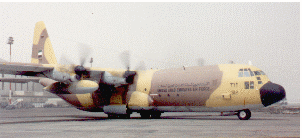 so
I posed in front of the mobile staircase for commercial jetliners. Pretty
silly, I know, but... The Kuwaiti Free Air Force. These guys escaped into
Saudi at the beginning of the conflict with about three aircraft... among
them, this Herk,
so
I posed in front of the mobile staircase for commercial jetliners. Pretty
silly, I know, but... The Kuwaiti Free Air Force. These guys escaped into
Saudi at the beginning of the conflict with about three aircraft... among
them, this Herk, 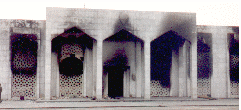 which
flew the first "official" airlift into Kuwait City following
Liberation. The Royal Terminal had been used as some sort of headquarters.
which
flew the first "official" airlift into Kuwait City following
Liberation. The Royal Terminal had been used as some sort of headquarters.
 Apparently,
two "smart bombs" found the front door, and just blew the interior
all to hell. This is also where I saw my first unexploded hand grenade.
One of the symbols of freedom... a Kuwaiti military vehicle flying the
Kuwaiti flag as it drives down the taxiway. The driver and passengers were
singing as they drove by me.
Apparently,
two "smart bombs" found the front door, and just blew the interior
all to hell. This is also where I saw my first unexploded hand grenade.
One of the symbols of freedom... a Kuwaiti military vehicle flying the
Kuwaiti flag as it drives down the taxiway. The driver and passengers were
singing as they drove by me.
So, what else can I tell you? I spent 211 days in theater, logged over 200 hours of combat, combat support, and contingency logistics hours flying around the peninsula, learned some Arabic, bought gold, and learned that CNN had a better intelligence network that most flying wings. I didn't like it, but I didn't hate it either. Many people - friends, family, total strangers - wrote letters, sent packages, and called in encouragement. I worked with a great bunch of folks, both at the ALCC (1610th Airlift Division (Provisional)), and in the Airlift Wings. There's no finer bunch of folks than the ones who fly the Herks and the folks who support the mission.
If you want to learn more about the airplane, visit the C-130 web page.
Visit Hercules Headquarters, the finest site on the web for C-130 related information and links.
 Last updated on 22 March 1999 by Chris Miller
Last updated on 22 March 1999 by Chris Miller 